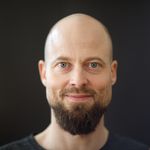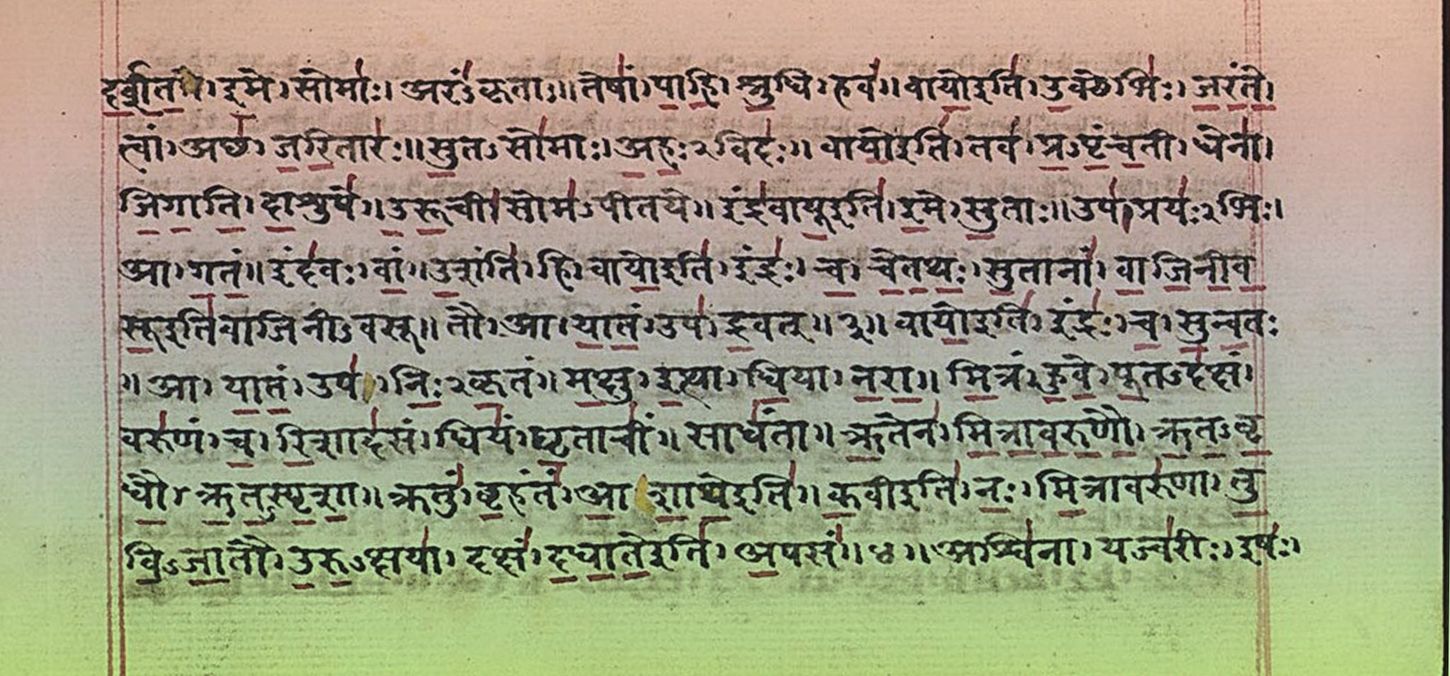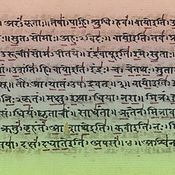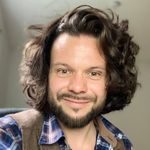
Der Purusha, zollhoch, als innre Seele
Ist stets zu finden in der Geschöpfe Herzen;
Nur wer an Herz und Sinn und Geist bereitet, –
Unsterblich werden, die ihn also kennen.
Paul Deussen - 1897
| Kommentar: | Dieser Vers (bis auf die erste Zeile Shvet.4,17 wiederholt) ist eine Fusion aus Kâth.6,17 und Kâth.6,9, wo (vgl. Mahânâr.1,11. Shvet.4,20) die ursprüngliche Form des Spruches erhalten ist. |
6The person (purusha), not larger than a thumb,
dwelling within, always dwelling in the heart of man, is perceived by the heart, the thought 1, the mind; they who know it become immortal.
Max Müller - 1879
<Cf. Taitt. r. X, 71 (Anuv. 38, p. 858). Kath. Up. IV, 12-13; above, p. 16.>
The Person has a thousand heads,
A thousand eyes, a thousand feet;
He surrounds the earth on all sides,
And stands ten fingers’ breadth beyond.5
Robert Hume - 1921
| 5: | This stanza = RV. 10. 90. 1; VS. 31. 1; SV. 1. 618; TA. 3. 12. 1; AV. 19. 6. 1. |
Der Purusha mit tausendfachen Häuptern,
Mit tausendfachen Augen, tausend Füßen
Bedeckt ringsum die Erde allerorten,
Zehn Finger hoch noch drüber hin zu fließen.
Paul Deussen - 1897
2The person (purusha) with a thousand heads. a thousand eyes, a thousand feet, having compassed the earth on every side, extends beyond it by ten fingers' breadth.
Max Müller - 1879
| 2: | This is a famous verse of the Rig-veda, X, 90, 1; repeated in the Atharva-veda, XIX, 6, 1; Vâg. Samh. XXXI, 1; Taitt. r. III, 12, 1. Saṅkara explains ten fingers' breadth by endless; or, he says, it may be meant for the heart, which is ten fingers above the navel. |
The Person has a thousand heads,
A thousand eyes, a thousand feet;
He surrounds the earth on all sides,
And stands ten fingers’ breadth beyond.5
Robert Hume - 1921
| 5: | This stanza = RV. 10. 90. 1; VS. 31. 1; SV. 1. 618; TA. 3. 12. 1; AV. 19. 6. 1. |
Nur Purusha ist diese ganze Welt,
Und was da war, und was zukünftig währt,
Herr ist er über die Unsterblichkeit,
Diejenige, die sich durch Speise nährt.
Paul Deussen - 1897
That person alone (purusha) is all this, what has been and what will be; he is also the lord of immortality; he is whatever grows by food3.
Max Müller - 1879
| 3: | Sâyana, in his commentary on the Rig-veda and the Taitt. r., gives another explanation, viz. he is also the lord of all the immortals, i.e. the gods, because they grow to their exceeding state by means of food, or for the sake of food. |
The Person, in truth, this whole world is,
Whate’er has been and whate’er will be;
Also ruler of immortality,
[And] whatever grows up by food.6
Robert Hume - 1921
| 6: | This stanza = RV. 10. 90. 2; VS. 31. 2; SV. 1. 620, AV. 19. 6. 4; TA. 3. 12. 1, with variants. |
Nach allwärts ist es Hand, Füße,
Nach allwärts Augen, Haupt und Mund,
Nach allen Seiten hin hörend,
Die Welt umfassend steht es da.
Paul Deussen - 1897
Its4 hands and feet are everywhere, its eyes and head are everywhere, its ears are everywhere, it stands encompassing all in the world5.
Max Müller - 1879
| 4: | Saṅkara explains sattvasya by antahkaranasya. |
| 5: | I take prâpti, like other terms occurring in this Upanishad, in its technical sense. Prâpti is one of the vibhûtis or aisvaryas, viz. the power of touching anything at will, as touching the moon with the tip of one's finger. See Yoga-sûtras, ed. Rajendralal Mitra, p. 121. |
It has a hand and foot on every side,
On every side an eye and head and face,
It has an ear everywhere in the world.
It stands encompassing all.7
Robert Hume - 1921
| 7: | This stanza = BhG. 13. 13. |
Durch aller Sinne Kraft scheinend
Und doch von allen Sinnen frei,
Als Gott und Herrn der Welt [ehrt ihn],
Als großen Hort des Weltenalls.
Paul Deussen - 1897
Separate from all the senses, yet reflecting the qualities of all the senses, it is the lord and ruler of all, it is the great refuge of all.
Max Müller - 1879
Seeming to possess the quality (guṇa) of all the senses,
It is devoid of all the senses!1
The lord (prabhu), the ruler of all,
The great shelter of all—
Robert Hume - 1921
| 1: | The first two lines occur as BhG. 13. 14 a, b. |
Der in der Stadt mit neun Toren (vgl. Kâth.5,1)
Als Schwan wohnend (Shvet.1,6) nach außen schweift9,
Der ist der ganzen Welt Herrscher,
Alles dessen, was steht und geht.
Paul Deussen - 1897
| 9: | Das Subjekt des Erkennens, indem es durch die Sinne wahrnimmt, "schweift gleichsam" nach außen, lelâyati iva, wie es in der ursprünglichen Stelle Brh.4,3,7 heißt, woher wohl mit dem Ausdrucke die Vorstellung entlehnt ist. |
The embodied spirit within the town with nine gates6, the bird, flutters outwards, the ruler of
the whole world, of all that rests and of all that moves.
Max Müller - 1879
| 6: | Cf. Taitt. r. X, 71 (Anuv. 38, p. 858). Kath. Up. IV, 12-13; above, p. 16. |
Though in the nine-gated city2embodied,
Back and forth to the external hovers the soul (haṁsa),
The Controller of the whole world,
Both the stationary and the moving.
Robert Hume - 1921
| 2: | That is, in the body, cf. Kaṭha 5. 1 and BhG. 5. 13. |
-
Verse 13-18 zum Einüben der Rezitation: https://youtu.be/Ij3uIpDgsmM
Ein paar Gedanken zu den Versen 13 und 14:
Vers 13. Wenn die "Höhle Brahmas" im physischen Bereich des Zwischenhirns [...] Verse 13-18 zum Einüben der Rezitation: https://youtu.be/Ij3uIpDgsmM
Ein paar Gedanken zu den Versen 13 und 14:
Vers 13. Wenn die "Höhle Brahmas" im physischen Bereich des Zwischenhirns lokalisiert werden kann, so kann unser wahres Selbst (puruṣa, christlich: Gotteskind, Sohn Gottes) also an einem Ort "im Herzen" (gebräuchliches Synonym für Gehirn) wahrgenommen werden, der nicht mehr als daumengroß ist - aṅguṣṭhamātraḥ, puruṣo'ntarātmā.Darauf mit Herz (hr̥dā), Sinn (manīṣā) und Verstand (manas) ausgerichtet Sein (abhikl̥pto) mag wirklich zu einer Erfahrung von Unsterblichkeit (amr̥ta, christlich: Geburt des Gotteskindes/Sohnes Gottes) führen.
Vers 14. Von einem Yogi hörte ich einmal die Bemerkung, dass das Sahasrara-Chakra, der "tausendblättrige Lotus", auch als "Platz der zehn Finger" bezeichnet würde und ein Ort sei, an dem wir den Vater, das Absolute, Brahma, oder wie man es nennen möchte, in uns erfahren können. In diesem Vers nun kommt dreimal die Zahl tausend (sahasra) vor und einmal werden die zehn Finger (daśāṅgulam) erwähnt. Kein Zufall, denke ich. Brahma, Gott Vater, der absolute Aspekt von Gottes Dreifaltigkeit, steht, so betrachtet, zehn Finger über allem (aty atiṣṭhad daśāṅgulam).
Wie gelangt man nun zum "Platz der zehn Finger"?
Dafür halte man Zeige- bis kleinen Finger der linken Hand gestreckt und aneinander, lege diese dann mit der Fingerkuppe des kleinen Fingers am Platz zwischen den Augenbrauen auf die Stirn, lege die gleichen vier Finger der rechten Hand daran und zuletzt noch Zeige- und Mittelfinger der linken Hand. Dann ist man dort: am Scheitelpunkt, Sahasrara Chakra.-
Wau. Super spannend. Vielen Dank für's Teilen. Wau. Super spannend. Vielen Dank für's Teilen.
-
-

Melanie Brunner
am 26.07.2021Hallo, ist bei 3.15 im dritten Pada - utāmrṭatvasyeśāno - das r ein Sonant und somit "mrṭa" zwei Silben, oder tatsächlich ein Konsonant und dann nur eine Silbe? Danke für die Hilfe. Hallo, ist bei 3.15 im dritten Pada - utāmrṭatvasyeśāno - das r ein Sonant und somit "mrṭa" zwei Silben, oder tatsächlich ein Konsonant und dann nur eine Silbe? Danke für die Hilfe.
-
Oh ja. Das war ein Fehler. Ich habe es gleich korrigiert. Danke für den Hinweis. Es sollte r̥ sein, also ein Sonant. Oh ja. Das war ein Fehler. Ich habe es gleich korrigiert. Danke für den Hinweis. Es sollte r̥ sein, also ein Sonant.
-



 Dr. Ronald Steiner
Dr. Ronald Steiner
 Nils Jacob Liersch
Nils Jacob Liersch



Nachrichten und Bewertungen